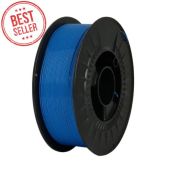We use cookies to make your experience better. Read more
16 April, 2025
PETG Filament: Exploring Temperature Resistance
Polyethylene Terephthalate Glycol-modified, or PETG, is one of the most popular materials in 3D printing, celebrated for its durability, transparency, and ease of use. This article dives deep into the temperature resistance of PETG filament, examining its strengths, limitations, and applications while keeping a focus on its relevance for technical parts and other demanding uses.
PETG Temperature Resistance: A Key Advantage
One of the defining attributes of PETG filament is its superior temperature resistance compared to many other 3D printing materials, such as PLA. PETG maintains its mechanical properties and shape integrity at temperatures up to 70°C, making it suitable for various interior and exterior applications. This resistance to heat degradation stems from its molecular structure, which includes modifications with glycol to enhance its stability and reduce brittleness.
Why Temperature Resistance Matters
Temperature resistance is critical in 3D printing applications where parts are exposed to heat, such as components used in mechanical systems, automotive industries, or outdoor settings. PETG’s ability to withstand moderately high temperatures without warping or losing strength ensures reliable performance, even in challenging environments. This makes it an ideal choice for functional prototypes, mechanical parts, and even certain food-safe applications, provided the right conditions and coatings are applied.
Comparing PETG and PLA: Heat Stability
While PLA is a popular material due to its ease of use and biodegradability, it has a relatively low melting point and is prone to deformation under heat. In contrast, PETG exhibits significantly better heat stability, holding its shape and structural integrity even when exposed to elevated temperatures. PLA loses its shape at 50–55°C, while PETG remains dimensionally stable up to 70°C[2][3][7]. This difference makes PETG the preferred choice for applications requiring durability and thermal resistance.
Applications Leveraging Heat Resistance
- Manufacturing: Durable parts for equipment and prototypes.
- Automotive: Heat-resistant components in engine compartments or exposed parts.
- Outdoor Fixtures: Weather-proof items that endure sunlight and temperature fluctuations.
Printing PETG: Optimal Settings for Heat Stability
- Nozzle Temperature: Start at 230°C for the first layer and increase to 240°C for subsequent layers to enhance layer adhesion and part strength.
- Bed Temperature: Use a heated bed set to 80°C for the first layer and 70°C for subsequent layers. A consistent bed temperature prevents warping and ensures a stable base for the print.
- Cooling: Proper cooling is essential. Too much cooling can weaken layer adhesion, while too little can lead to deformation. Start with a moderate setting and adjust as needed for optimal results.
Addressing Common Challenges
- Stringing: Adjust retraction to reduce filament oozing. A retraction tower test can help identify the best parameters.
- Bed Adhesion: To prevent excessive sticking, consider using a glass bed with PVA glue or a powder-coated print sheet or PEI smooth plate.
PETG in Extreme Conditions
PETG’s combination of toughness, impact resistance, and moderate thermal stability makes it a reliable choice for technical applications. Unlike PLA, which can deform under relatively low temperatures, PETG parts maintain their functionality even when subjected to stress in moderately heat-intensive environments. For applications requiring even greater heat resistance, users may explore advanced materials, but PETG’s affordability and accessibility often make it the best overall option for medium-temperature use.
Applications Benefiting from PETG’s Heat Resistance
- Industrial Components: PETG is commonly used for gears, brackets, and fixtures that require both durability and moderate heat resistance.
- Medical Devices: The material’s stability and transparency make it suitable for applications like test tube racks and medical models.
- Packaging: PETG’s resistance to heat and impact ensures the safe transport of products, particularly in environments where temperature fluctuations occur.
- Signage and Displays: Its clarity and thermal stability make PETG ideal for durable, high-quality displays.
Why PETG is the Material of Choice
While PLA remains a beginner-friendly and environmentally conscious option, PETG’s superior mechanical properties and thermal resistance make it indispensable for advanced and technical applications. Its ability to combine strength, flexibility, and heat stability ensures consistent performance across diverse industries, from manufacturing to creative design.
Conclusion
PETG filament’s temperature resistance is a standout feature that enhances its versatility and value in 3D printing. For most applications, PETG is stable up to 70°C, but long-term or load-bearing use above this temperature may cause deformation. By understanding its properties and optimizing print settings, users can achieve reliable, high-quality results for applications requiring durability and moderate thermal stability.



Please complete your information below to login.
Anmelden
Neuen Account erstellen